No need for 100 horses or more to roam the roads! The new generation of sports 250/300 cm3 can already have fun and against all odds! The idea of this comparison, organized in collaboration with our colleagues of Moto Revue, was to join the south of France, and in particular the Paul Ricard circuit, by privileging the secondary network. Or, a journey rather tantalizing on paper and that would allow to gauge the potential of each bike here, each already tested solo on the circuit: the KTM RC390, the Suzuki GSX 250 R and the Yamaha YZF-R3. Three small sports approved for the A2 license and all indicated to become your very first bike.
To further optimize their performance in this 250/300cc sports comparison, we took care to change their tires, with the key to a serious bonus of fun all along the more than 1,000 km passed on their handlebars. The planets were almost aligned, except the weather factor. In the end, we had the right to the fleet a good half of the time, and enjoyed the second on small roads sometimes deserted and above all, dry! Of these simple but oh so essential little happiness of the "test rider" of the station, what. But let's get into the thick of it now.
KTM RC390: Mono Culture
Undeniably, the KTM RC390 is the most "original" of the lot: very special front face, foam rear part that mimics a single-seat hull (very well done!), Tubular steel truss frame and most importantly, the only single-cylinder engine of this comparative, a still very popular architecture of KTM. Its presentation is therefore the most singular while the quality of its finish is uneven, between a correct assembly, beautiful parts such as the aluminum swingarm, and connectivity too obvious. Since the beginning of her career, the Austrian has received an evolution of the escapement and cladding (shoe) at the same time as an adaptation to the Euro 4 standard.
Moto3 Road
To fully appreciate the KTM RC390, it is necessary to accept the concessions, more than on others, logical reversal of such an atypical personality. This is illustrated in particular by the level of vibrations of its single cylinder - which remain bearable - and its chronic lack of flexibility. Fortunately, the clutch control is ultra flexible and the selection of nice box. Above all, this engine does not lack energy, the most nervous of the comparative. He drops the others during the tests of recoveries, accelerates more strongly at mid-revs, and has a sacred elongation (for a mono)! On track, it raises the display to more than 180 km/h, not bad for 43.5 horses!
And the KTM RC390 is also worth the detour by the behavior of its chassis. This one is perfectly up to the performance of the engine, with the key to the best homogeneity of the comparison. The rigidity of the chassis is undoubtedly the most noticeable on the "Katoche", and directly controls its course stability or stability curve, irreproachable. In addition, between the narrowness and support on the front, the RC390 provides the sportiest ergonomics of the lot, which allows an excellent feeling in sports driving on road or circuit. Finally, it brakes enough, even if, as for our three motorcycles of the day, the feeling to the lever appears spongy compared to sporting 600 cm3 and more, the fault to more basic equipment.
KTM RC390: The Most Powerful
Between its offbeat look and its singular technique, the KTM RC390 is undeniably the most original of this comparison. Arguments that can seduce or repel, like its offset look or high seat height (820 mm). If it is also the most efficient overall (engine and chassis), it requires more instructions for use, especially for its single-cylinder engine with a sacred character. Depending on whether we like the Austrian style or not, the KTM RC390 will be the most endearing of our trio of dwarfers, especially since it does not "overpay" its originality: € 5,795.
Plus:
- Offbeat look
- Character and performance of the mono!
- Precise and homogeneous part-cycle
- Acceptable comfort
Minus:
- Uneven finish
- Legibility of the dashboard
- Saddle height
- Manual
Suzuki GSX 250 R: The R utility
The Suzuki GSX 250 R is a novelty in the second half of 2017. On the occasion of our first test, the little "GSX" had unveiled its potential despite its original pneumatic tires (IRC Roadwinner, or "Roadloser" in the rain especially). His presentation is undoubtedly the most successful of the lot, with rewarding curves, a beautiful painting, a readable and complete scoreboard. Its ergonomics are the most welcoming of the comparator, with a seat height of 790 mm, which is favorable to small builders and a position as pleasant in the city as on the road.
It is also the GSX 250 R which reveals here the most obvious grip, by far! All its controls are ultra soft, electronic injection without jerks. The little Suzuki finally erases her weight (183 kg all measured facts, the heaviest of the day) revealing a maneuverability and ease disconcerting. Only the KTM is much brighter on the road in the winding.
A non-violent sport
However, if the KTM has the best weight / power ratio (with 43.5 hp for 167.4 kg all full facts), the Suzuki has the worst (with 25 hp 183 kg). Its parallel twin engine of 248 cc certainly shows a deficit in displacement, but is not very efficient in the absolute and for good reason, it is derived from the utility Inazuma 250. Also, it is with the Suzuki that we must anticipate more overtaking on the road, or even give up sometimes to follow the other two.
And we hardly dare to imagine the duo raises with the 25 ponies at the end of the handle! At least, with 141 km/h peak (counter), there is less risk of being flashed. And we are all the more pained at its poor performance that its part-cycle is very pleasant (and for good reason), always healthy, as stable as predictable, especially with the Mitas MC50 tires mounted for testing.
Suzuki GSX 250 R: Start first
Very cute, the Suzuki GSX 250 R is also the easiest to discover, to live on a daily basis, even to drive and this despite the highest weight of this comparative, proof of its perfect balance. Perfect for beginners, it will be less able to support the progression of a beginner. And its price of € 5,399 seems too high in view of this global potential.
Plus:
- Line
- Ease of driving
- Smooth engine
- Healthy behavior
Minus:
- Modest performance
- Standard tires
- More "GSX" than "R"
Yamaha YZF-R3: A family of R
The YZF-R3 is the entry-level Yamaha sporty + 125 cm3. It is very successful in Asia and should improve its image along with its commercial results thanks to its compliance with the extended A2 licensing regulations and its excellent results in the 300 Supersport Championship. In short, it's a small sport is a "YZF". Here, its manufacture appears the most rigorous, even if it does not exhibit as beautiful parts as the KTM (swingarm, standard fork).
Ergonomically, the Yamaha YZF-R3 has a low seat (780 mm), but its footrest too raised (distance saddle / RP: 440 mm) requires more fold for the legs facing the other two, embarrassing to the long. But the Yamaha also has a handlebar more comfortable than the KTM, the best protection and mirrors the most efficient of the day.
Raguer and docile at the same time
In fact, on the road, she appears quickly in her element. Especially since its 42-horsepower online twin makes good availability. It is fuller than the twin Suzuki, more flexible than the mono KTM and has an elongated length. As a result, here is an easy-to-use and efficient engine, if not to compete with the mechanical excitement of the KTM and the approval of the Suzuki's controls. We would have liked the twin Yamaha to sing (or breathe via its air box) with as much joy as the mono KTM.
Side performance chassis, Yamaha YZF-R3 cuts less well trajectories than the KTM or Suzuki, but presents a judicious mix between rigor and comfort. Certainly, we quickly understand that we can do everything with this bike: the city, road courses in comfort worthy of the name, have fun in the turns once mounted Pirelli Diablo Rosso II (among others). In short, here is a small bike closer to the Sport-GT philosophy than Sportive.
Yamaha YZF-R3 balance sheet: The most versatile
Sold for € 5,799, the Yamaha YZF-R3 evolves midway between the KTM and the Suzuki. Less powerful than the RC 390 but more than the GSX 250 R and just one step below the comfort of the Suzuki. The Yamaha YZF-R3 is therefore a very good choice for bikers little camped in a particular use.
Plus:
- General approval
- Comfort/Duo preserved
- Daily versatility/road/sport
Minus:
- Leg fold
- Spongy braking
KTM RC390 vs Suzuki GSX 250 R vs Yamaha YZF-R3 Comparation
Convenient
KTM RC390
Price: 5 795 €
Color: Black orange, black
Warranty: 2 years, parts and MO, unlimited km
Homologation: A2 license, A license, two-seater, Euro 4
Place of manufacture: India, KTM / Bajaj
Suzuki GSX 250 R
Price: € 5,399 (black), € 5,499 (MotoGP blue)
Color: black, MotoGP blue
Warranty: 2 years, parts and MO, unlimited km
Homologation: A2 license, A license, two-seater, Euro 4
Place of manufacture: China, Suzuki factory
Yamaha YZF-R3
Price: 5 799 €
Color: black, blue
Warranty: 2 years, parts and MO, unlimited km
Homologation: A2 license, A license, two-seater, Euro 4
Place of manufacture: Thailand, Yamaha factory
Technical sheet
Technical sheet
KTM RC 390:
Engine: 373.2 cc, 4 stroke, single cylinder, bore 89 mm x stroke 60 mm, dual ACT and 4 valves, liquid cooling, electronic injection diam. 46 mm, 6 speed gearbox, electric starter, chain drivePower 43.5 hp. (32 kW) at 9,500 rpm, torque 3.5 daNm at 7,250 rpm
Cycle part : steel tube truss frame with integral rear buckle, inverted hydraulic fork diam. 43 mm, deb. 125 mm; mono-shock AR deb. 150 mm, adjustable in prestressing; disconnectable ABS brake as standard, AV 1 disc diam. 300 mm / radial calliper 4 pistons - AR disc diam. 230 mm / caliper 1 piston; front tires 110/70 x 17 - rear 150/60 x 17
Gauge: wheelbase 1340 mm (+ or - 15 mm), flush 88 mm / angle 23 ° 5, ground clearance 178.5 mm, seat height 820 mm, tank 10 l., Dry weight 147 kg / 167, 4 kg all full facts (MS checked)
Performance: maximum speed 185 km / h (meter), average consumption of the test 4.4 l / 100 km
Suzuki GSX 250 R:
Engine: 248 cc, 4-stroke, vertical twin, bore 53.5 mm x 55.2 mm stroke, 1 ACT, liquid cooling, electronic fuel injection, electronic ignition, 6-speed gearbox, electric starter, chain drivePower 25 hp. at 8,000 rpm, torque 2,3 daNm at 6,500 rpm
Cycle part : double cradle steel tubular frame, non-adjustable hydraulic fork, adjustable AR mono-damper in 6-position preload, standard ABS braking, AV 1 disc diam. 290 mm / caliper 2 pistons - rear disk diam. 240 mm / caliper 1 piston; front tires 110/80 x 17 - AR 140/70 x 17
Template: size (L x W x H) 2085 mm x 740 mm x 110 mm, wheelbase 1430 mm, ground clearance 160 mm, seat height 790 mm, tank 15 liters, weight 181 kg all full details (manufacturer) - 183 kg (verified MS)
Performance: maximum speed 141 km / h (11 000 rpm counter), average consumption 4.3 l./100 km
Yamaha YZF-R3:
Engine: 321 cc, twin-cylinder inline, 4 stroke, bore 68mm X stroke 44.1mm, water cooled, 2 ACT and 4hp / cyl, electronic fuel injection, 6 speed, electric starter, chain drivePower 42 hp. (31 kW) at 10,750 rpm, torque 3 daNm at 9,000 rpm
Part-cycle: tubular frame type diamond steel, telescopic fork diam. 41mm, non-adjustable, deb. 130 mm; mono shock absorber AR type monocross, adjustable in prestressing, deb. 125 mm; braking ABS, AV 1 floating disc diam. 298 mm / double piston caliper - rear disk diam. 220 mm / single piston caliper; front tires 110/80 x 19 - AR 140/70 x 17
Template: wheelbase 1 380mm, column angle 25 ° 5, seat height 780 mm, tank 14 liters, fully filled weight fact 169 kg (manufacturer) / 170.5 kg (MS checked)
Performance: maximum speed 180 km / h (meter), average consumption 4.5 l / 100 km
By Christophe Le Mao, Sylvain Le Bellec photos for moto-station.com

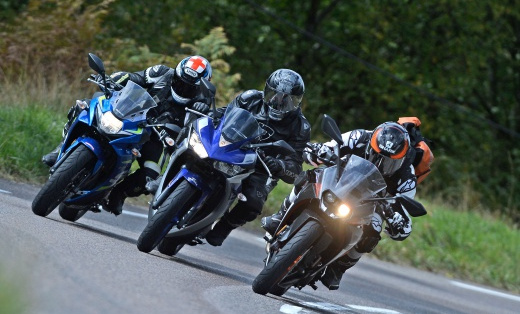


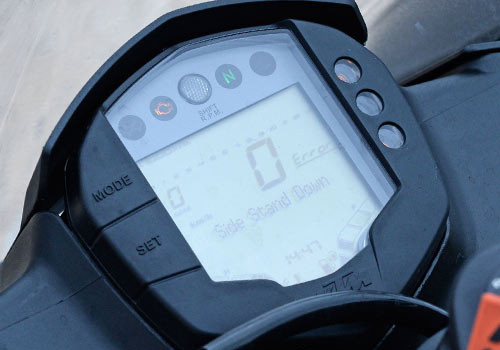

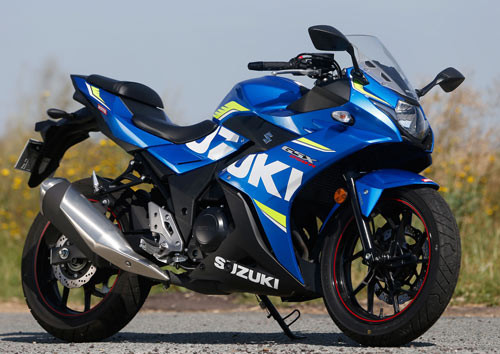


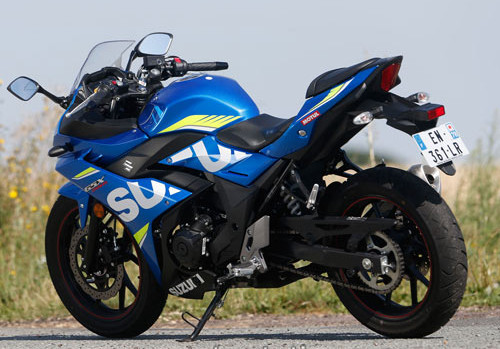
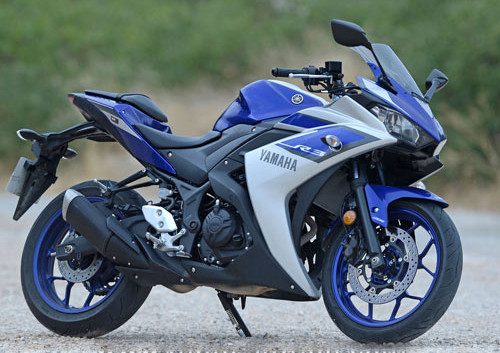


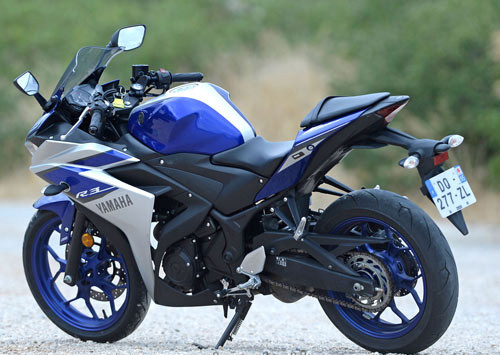
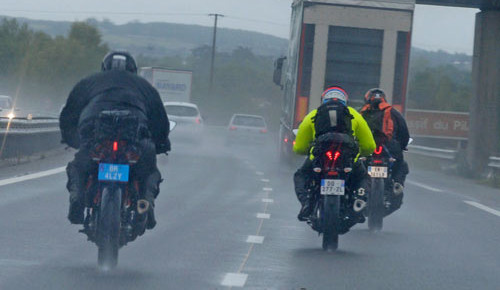
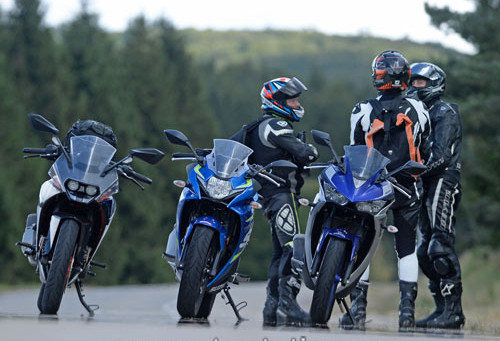

EmoticonEmoticon